Extruded polystyrene foam as insulation: material pros and cons + application tips
Extruded polystyrene insulation is considered the most popular material for the insulation of any buildings, moreover, both walls and floors and ceilings. But, like most other building materials, along with the pros, it has its drawbacks.
In this material we will try to analyze its strengths and weaknesses in more detail. And also talk about how to work with this material, observing fire safety measures.
The content of the article:
What is EPSP?
In everyday life, this material can be found under the name "foam", but this is fundamentally wrong. These two materials are significantly different from each other. For example, extruded polystyrene foam (EPS) is one of the most resistant to deformation and durable varieties, moreover, its heat-shielding properties hardly suffer from this.
High-strength EPSP is made on special production lines by chemical extrusion of the initial raw materials, which are pure polystyrene granules.
Using special equipment, the raw materials are converted into foam, from which, in turn, small granules are produced. These granules in the process of solidification are pressed into layers of the desired shape and size, after which they can be used not only for insulation of houses, but also for other purposes.
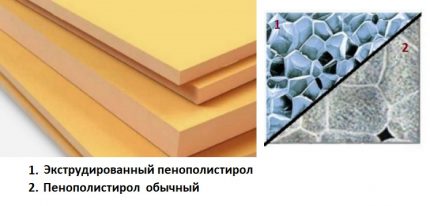
The main difference between extruded polystyrene foam and extruded polystyrene is in the characteristics of its granules. They are smaller, which makes this building material more resistant to physical stress.The granule size of the heat-insulating material produced by extrusion does not exceed 0.1 mm, while the pellets of the no-press can reach up to 10 mm.
In an overseas interpretation, EPSS may be referred to as XPS. It is released in several varieties. After the abbreviation "XPS" in the markings of this material there are numbers from 25 to 45, which indicate its density.
The larger the value, the higher the density of the material. Particularly dense extruded material can even be used to insulate road asphalt, for example, company products Penoplex.
Now that we’ve figured out what EPPS is, we’ll discuss all its pros and cons in detail.
The main advantages of the material
In fact, polystyrene is the same plastic, only endowed with other qualities. But from the fact that it is somewhat lighter and less dense, it does not cease to be just plastic, and therefore all the advantages of this material are inherent in it.
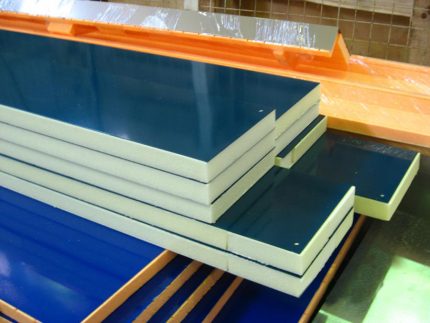
One of the main advantages of expanded polystyrene is lightness of material, but its other advantages are also no less significant:
- Resistance to fungal infections. As you know, a fungus needs to eat something for life. But synthetics, like food, do not suit him.
- Material does not decay and does not decay. Only natural, biological materials are subject to decay and decomposition. EPPS is, initially, a product synthesized from artificial polymers, and therefore there can be no decomposition.
- Resistance to compression. EPPS, especially high density, can withstand enormous loads.
- Lack of moisture absorption. Anyone knows that a plastic bag does not leak water. This quality is not alien to polystyrene foam.
- Frost resistance. The material does not freeze through, because there is simply no moisture in it. He is airy, but, at the same time, absolutely “dehydrated”.
- Low thermal conductivity. As already mentioned, this material is literally filled with air, namely, air is the most intense heat insulator.
Since EPSP is essentially plastic, it has low vapor permeability, which in many cases can be considered a positive quality. So, expanded polystyrene is successfully used for attic insulation.
Plus, polystyrene is resistant to most chemicals.
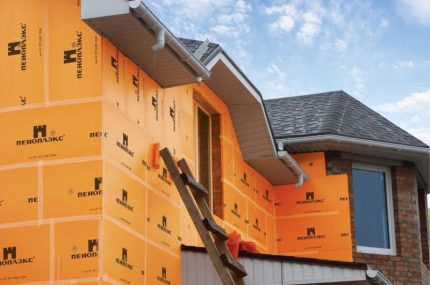
Also an impressive plus can be considered that:
- EPPS with its extreme strength has a very low weight, which reduces the load on the foundation if the material is used in the insulation of the upper part of the structure.
- It is very resistant to temperature changes. The temperature jumps almost do not expand and narrow its structure, as is the case with denser substances and materials.
- It is very easy to install, and since it can be easily cut even with a sharp knife, it is extremely easy to form a block or segment of non-standard geometry from it with extreme ease.
- Installation work on the insulation of buildings using EPSS can be performed at temperatures from -50 to +70 degrees Celsius, that is, almost all year round and in any climatic zones.
- It adheres well to other building materials. Even stucco adheres perfectly to it.
And if you add here also the durability of the material, you may get the impression that EPSP is a panacea for all ills.But, unfortunately, the insulation made from polystyrene foam has a number of its drawbacks.
Significant disadvantages of insulation
Despite the fact that the disadvantages of the material are much smaller than the pluses, in some cases they become a key reason to abandon its use.
As it turns out, plastic has not only advantages, and all the disadvantages of EPS are also due to the fact that it has a "polyethylene nature."
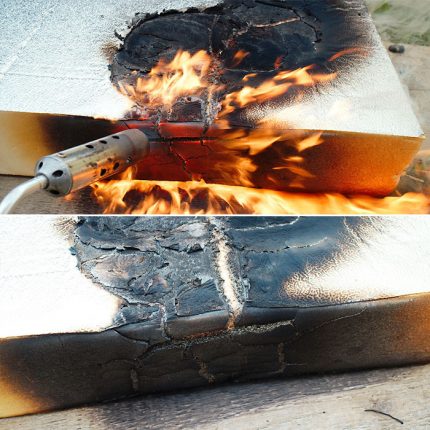
The main disadvantages of extruded polystyrene foam are:
- Poor sound insulation. The material is able to muffle sound waves a little, but it is not able to absorb them completely, as well as reflect them.
- UV sensitivity. Under direct sunlight without specially hiding materials, for example, plaster and other finishes, which serve, among other things, as protection, the EPSF is destroyed.
- Low vapor permeability. In some cases, this can be a plus. But not at all. Therefore, dwellings insulated with extruded polystyrene foam need flawlessly installed and efficient ventilation. Otherwise, condensation will accumulate in the walls, which will contribute to their destruction.
- Low environmental friendliness of the material. No matter how the manufacturers of expanded polystyrene block their product, but plastic always remains plastic. Even if it is porous, it will still decompose much longer than any non-synthetic substances.
- The cost of insulation this kind also drives some into thought. Moreover, the harder and denser its variety, the more expensive it is.
I would also like to dwell on the fact that, for obvious reasons, this material is very susceptible to attacks from rodents.
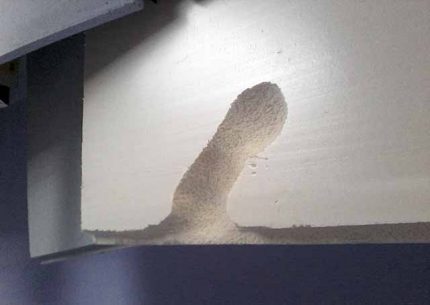
If there is open access to the insulation layer from EPSS, mice and rats make entire labyrinths of moves in it and even arrange their nests in them.
Therefore, it is advisable to carefully seal up the insulation layers with such finishing materials through which rodents cannot break through to the desired layer of expanded polystyrene.
But the main disadvantage of this kind of material is the low degree of resistance to fire. As soon as the edge of the stove lights up, the flame instantly eats it completely. Moreover, combustion is accompanied by the release into the atmosphere of highly toxic substances - phenols, which can cause no less dangerous harm to the lungs than the high temperature itself.
Conventional extruded polystyrene foam can catch fire, depending on the prevailing external factors, at a temperature of 250 to 450 degrees Celsius, which is why it should be used with great caution to warm wooden buildings and structures.
In such cases, experts advise you to buy EPS, flavored in the production process with special refractory additives.
Rules for working with material
Most often, extruded polystyrene foam is used to warm foundations, floors, walls and ceilings of residential and commercial buildings. For example, for loggia wall insulation/ balcony or walls of a residential apartment from the inside.
But those who decide to use this material to warm their own buildings should remember a few rules.
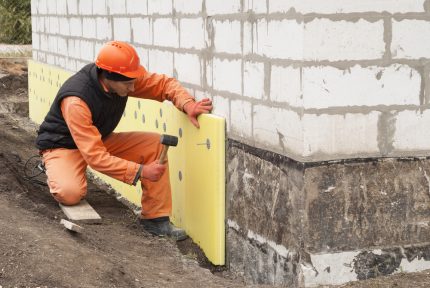
What do EPS plates fit on?
Plates of extruded polystyrene foam are well attached to a flat and dense vertical surface with special varieties of glue. As it can be Penoplex FASTFIX, TechnoNIKOL or dilutable adhesive mixtures such as Ceresit CT 83.
If you are reluctant to bother with glue, or the surface structure does not allow this, you can resort to using fasteners such as special dowels. In general, before warming it is desirable to level the surface of the walls with at least rough plaster and put the boards on both of the fasteners mentioned above, both on glue / cement mortar and dowels.
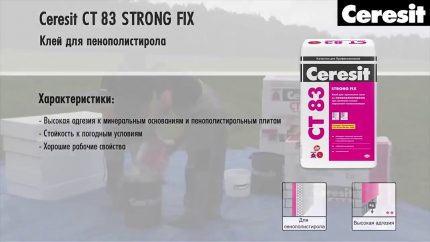
Warming of foundations and floors
In the case of foundations, EPSP boards are laid around all its external sides, after which the newly made thermal insulation layer is covered with a waterproofing layer. Often, homeowners decide to insulate even blind area.
In this case, a layer of concrete is formed over a layer of polystyrene foam, which, in turn, rests on a cushion of sand and gravel.
A concrete floor screed is also built on top of the evenly laid EPS panels.
EPSP is also used as one of the methods of warming wooden floors. We talked about this in more detail in next article.
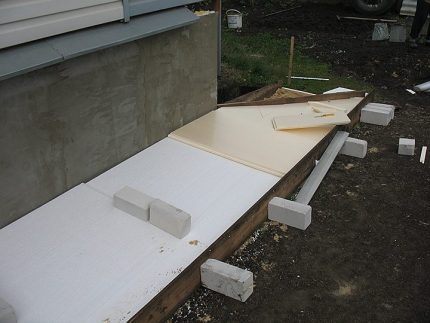
Styrofoam plate cutting
Since the density of the extruded polystyrene foam is an order of magnitude higher than that of conventional, a number of small problems arise with this. For example, this type of material can still be cut with a knife, but, firstly, its blade must be exceptionally thin and strong, since a thick blade can lead to coloring and cracking of the plate.
And secondly, the creak and rattle that will accompany such an "event" will be an order of magnitude higher than in the case of conventional polystyrene foam. Therefore, before starting the procedure, it is recommended to lubricate the blade of the knife with machine oil.
Someone uses a grinder equipped with the thinnest metal circle to cut blocks from EPS. Cutting, in this case, is effective, but the whistle is such that it is better to insert plugs in the ears. Among other things, this method is the most "unclean". After it remains a huge amount of garbage.
If you decide to use a grinder for cutting polystyrene foam, we recommend that you familiarize yourself with terms of use this equipment.
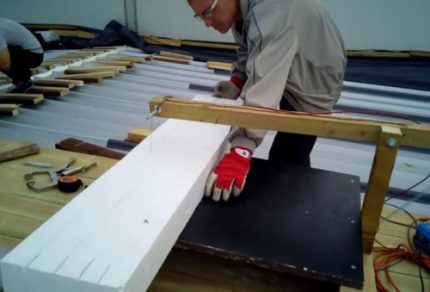
The most effective and easiest method is cutting with a hot wire. Two nails are taken, between which a wire of nichrome is stretched. Voltage is applied to the nails through a transformer, the wire is heated and the process has begun. Using this method, you can cut the most accurate blocks and shapes of high degree of complexity.
But this method is the most harmful. As already mentioned, the phenol vapors released during the cutting process can cause significant harm to the human body, and therefore, this procedure should be performed outdoors, preferably in a draft or by using a special respirator, or even a gas mask.
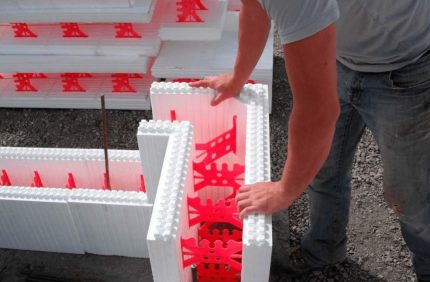
Fire precautions
When working with extruded polystyrene foam, you must follow strict fire safety measures, otherwise it will be much more difficult to extinguish the flammable material than it seems.
That is why in case work is carried out using open fire, for example, there is a furnace with which bitumen is melted, etc., you should always have a hose with a water supply, a fire extinguisher or, at worst, a water barrel and a bucket .
The same is advised to do when conducting welding in the immediate vicinity of the EPS. Moreover, here it is advised either to block the material from sparks and dross flying from welding, or to pre-moisten nearby polystyrene plates with water, it is better to do both at the same time. Only in this case will you protect yourself and your building from fire.
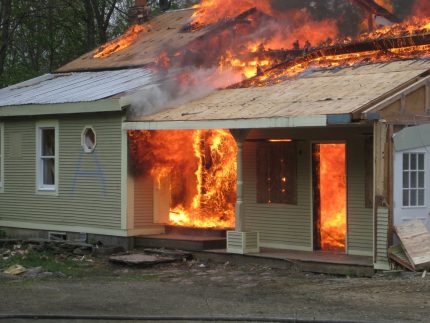
Conclusions and useful video on the topic
You can learn about the criteria by which to choose extruded polystyrene from the following video:
Considering that almost no one pays attention to the poor sound insulation of the insulation, sensitivity to ultraviolet radiation is treated by the fact that the material is always protected by a finish layer, and low vapor permeability as a minus is eliminated by the presence of good ventilation, only “non-environmental friendliness” and "High cost" of the material, but these shortcomings are also easy to refute.
The very concept of "not environmentally friendly" suggests that that the material is exceptionally durable, because over time, especially with proper use, it does not break down into components. But is this not a criterion in order to consider the "non-environmental friendliness" of building material a plus? Well, at the expense of the high cost of EPSP, you can bring an excellent proverb: "Avaricious pays twice." With all the morality and consequences.
Thinking about using EPSS as a heater and want to clarify a couple of nuances of its use after reading our material? Ask the remaining questions to our experts below under this publication - we will try to help you.
If you are professionally engaged in the installation of EPSS and want to give useful tips to beginners or to supplement the above material with valuable comments, write your comments in the block below.

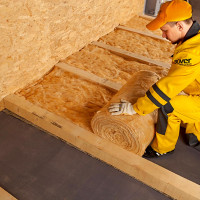 Insulation for the floor in a wooden house: materials for thermal insulation + advice on choosing insulation
Insulation for the floor in a wooden house: materials for thermal insulation + advice on choosing insulation 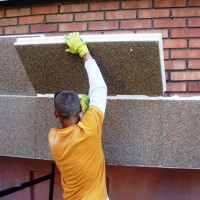 Insulation for walls of the house outside: an overview of options + tips for choosing an external insulation
Insulation for walls of the house outside: an overview of options + tips for choosing an external insulation 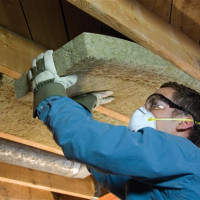 Insulation of the ceiling in a private wooden house inside and out: choosing the best material and the nuances of installation
Insulation of the ceiling in a private wooden house inside and out: choosing the best material and the nuances of installation 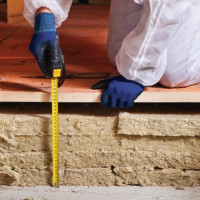 Warming of a wooden floor: popular insulation technologies + expert advice
Warming of a wooden floor: popular insulation technologies + expert advice 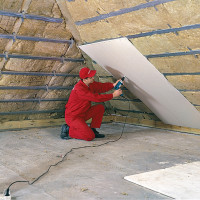 Do-it-yourself attic insulation from the inside: step-by-step instruction on insulation + tips for choosing materials
Do-it-yourself attic insulation from the inside: step-by-step instruction on insulation + tips for choosing materials 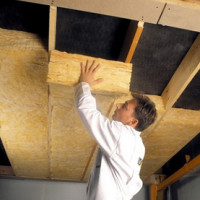 Insulation for the ceiling in a private house: types of materials used + how to choose the right
Insulation for the ceiling in a private house: types of materials used + how to choose the right  How much does it cost to connect gas to a private house: the price of organizing gas supply
How much does it cost to connect gas to a private house: the price of organizing gas supply  The best washing machines with dryer: model rating and customer tips
The best washing machines with dryer: model rating and customer tips  What is the color temperature of light and the nuances of choosing the temperature of the lamps to suit your needs
What is the color temperature of light and the nuances of choosing the temperature of the lamps to suit your needs  Replacement of a geyser in an apartment: replacement paperwork + basic norms and requirements
Replacement of a geyser in an apartment: replacement paperwork + basic norms and requirements